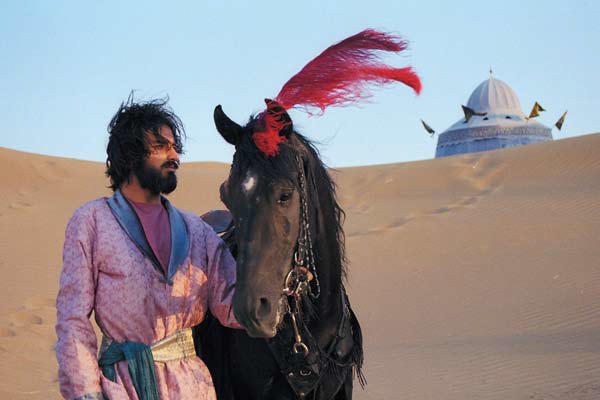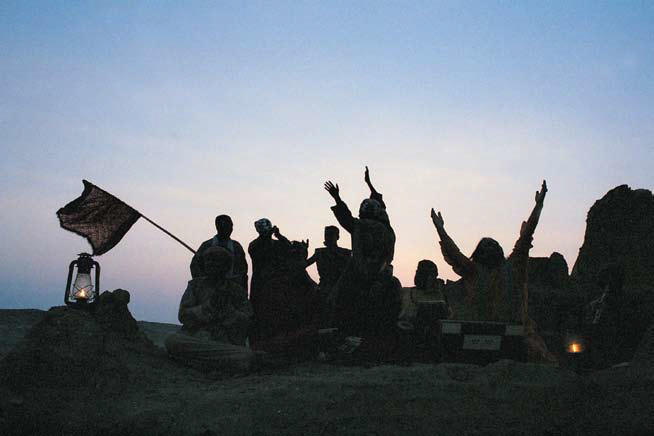
At first glance, Bab’Aziz: The Prince Who Contemplated His Soul seems like a veritable cornucopia of Oriental exotica. At second glance, too. There are forbidding desert vistas, a blind, wizened dervish, gnomic utterances, and elaborate digressions into vaguely mystical stories.
And, of course, a prince contemplating his soul.
Some may even hold the film’s overwhelming visual beauty against it — shot in Tunisia and Iran, Bab’Aziz unfolds across a backdrop of rolling, sensuous sands, often caught in dreamy twilight by Iranian cinematographer Mahmoud Kalari. And yet Bab’Aziz has proven to be something of a hit on the festival circuit, premiering in Dubai in 2004 and making appearances in Cairo, Istanbul, Muscat, and Fajr, where it won a major prize in 2005. (It was released theatrically in the US in February 2008.) There’s little doubt that it has been warmly received by viewers in the Middle East and elsewhere; what then to make of its seeming embrace of a fairy-tale version of the Muslim world?
Perhaps we should blame 9/11. Nacer Khemir, the film’s Tunisian director, has claimed that Bab’Aziz is meant to be read politically. “I tried to wipe Islam’s face clean with my movie,” he told an interviewer, “by showing an open, tolerant, and friendly Islamic culture, full of love and wisdom… an Islam that is different from the one depicted by the media in the aftermath of 9/11…. This movie is a modest effort to give Islam its real image back.” Setting aside the vexed question of what it would mean to give Islam its “real image back” (and also, where its face is), Khemir’s film does offer a compelling study in contrasts. The obvious debt it owes to The Thousand and One Nights evokes an image of a world fixated on the past; but Khemir also tweaks his narrative in ways that suggest that this past may not be what it seems.
The story begins in the wake of a sandstorm, as the aged dervish Bab’Aziz and his young granddaughter Ishtar emerge literally from beneath the desert, on their way to a gathering of dervishes. We’re told little about the gathering, save that it happens every thirty years and no one knows where it’s held. To pass the time, Bab’Aziz tells Ishtar a story about a desert prince who follows a gazelle out into the sands one day and disappears. His men set out to find him; when they do, he’s staring into a pool of water, enraptured by his own reflection. This prince isn’t hypnotized by his own beauty, however. Rather, he is peering into his soul (more Siddhartha than Narcissus, as it were). He ends up losing his earthly kingdom. But does he gain something else? The film doesn’t say, precisely, though we’re invited to wonder whether he might, perchance, have become a dervish himself, a dervish with a young granddaughter, on a journey to what seems like nowhere in particular…
But Bab’Aziz is not merely the tale of the prince. It’s a tapestry of stories, connected in a variety of ways, told by Bab’Aziz himself and by travelers he encounters along the way. Perhaps the most notable of these tales is related by a young man named Zaid, searching for a beautiful woman named Nour, whose heart he won in a poetry contest, at which point she disappeared. The contest is seen in flashback; Zaid’s verses remind Nour of her own father’s words, prompting her to fall in love with the young man. Zaid has been searching for her ever since and hopes to find her at the gathering of the dervishes.

The film obviously elicits comparisons to The Thousand and One Nights. But with its intricate narrative structure, its stories within stories, and its deferred resolutions, Bab’Aziz bears even closer resemblance to one of the Nights’ palimpsests in Western culture: Pier Paolo Pasolini’s 1974 film The Arabian Nights, which shares with Khemir’s film a matter-of-fact fascination with ritual. Indeed, despite its director’s Tunisian background and his manifest concern for the image of Islam, Bab’Aziz’s aesthetic DNA feels distinctly European, notably Italian. Khemir’s collaborator on the script was the legendary Tonino Guerra, Michelangelo Antonioni’s partner on L’Avventura, La Notte, and Blow Up, among other films. (Guerra has had fruitful collaborations with Andrei Tarkovsky, Francesco Rosi, Federico Fellini, the Taviani brothers, and Theo Angelopoulos as well.) The sensuous depiction of the desert as a place for the submersion of identity and for endless quests, for rebirth and for reinvention, also recalls Bernardo Bertolucci’s The Sheltering Sky and Valerio Zurlini’s Desert of the Tartars, not to mention The Passenger (interestingly, one of the few major Antonioni films Guerra did not write).
But it is precisely in its treatment of the desert that the fantastic aspect of Khemir’s film turns back on itself. Whereas the film at first seems to be set in the distant past, as the travelers’ journey progresses, traces of the present creep into the story. There are images of trucks, a reference to a bus, and other glimpses of the world beyond. Zaid’s final story is introduced with a shot of a passing airplane.
This young man with the baseball cap and the backpack walking across the desert sands with the blind, turbaned mystic and his wee granddaughter makes for a seductively incongruous image. It also presents the film with one of its most powerful moments. When a tired and weakened Bab’Aziz requests that Ishtar leave him and proceed to the gathering with Zaid, the girl refuses, struggles, but finally relents, leaving behind forever the old man who was once, perhaps, a prince. Ishtar’s journey, in that sense, mirrors that of the film itself. Bab’Aziz ultimately finds itself in an ambiguous place, open to the world at large and uncertain as to what new marvels the future holds.